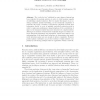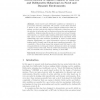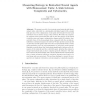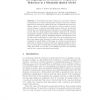ECAL
2007
Springer
14 years 3 months ago
2007
Springer
Anticipation is one of the key aspects involved in flexible and adaptive behavior. The ability for an autonomous agent to extract a relevant model of its coupling with the environ...
ECAL
2007
Springer
14 years 3 months ago
2007
Springer
The “order for free” exhibited by some classes of system has been exploited by natural selection in order to build systems capable of exhibiting complex behaviour. Here we expl...
ECAL
2007
Springer
14 years 3 months ago
2007
Springer
To look for an answer to the puzzle of why complexity may increase, this paper looks to the major evolutionary transitions – a recurring pattern where individuals give up their r...
ECAL
2007
Springer
14 years 3 months ago
2007
Springer
Abstract. When bees and wasps leave the nest to forage, they perform orientation or learning flights. This behaviour includes a number of stereotyped flight manoeuvres mediating ...
ECAL
2007
Springer
14 years 3 months ago
2007
Springer
We describe two simple simulations in which artificial organisms evolve an ability to respond to inputs from within their own body and these inputs themselves can evolve. In the fi...
ECAL
2007
Springer
14 years 3 months ago
2007
Springer
Abstract. In psychology the ‘A not B’ error, whereby infants perseverate in reaching to the location where a toy was previously hidden after it has been moved to a new location...
ECAL
2007
Springer
14 years 3 months ago
2007
Springer
Language can be viewed as a complex adaptive system which is continuously shaped and reshaped by the actions of its users as they try to solve communicative problems. To maintain c...
ECAL
2007
Springer
14 years 3 months ago
2007
Springer
Both reactive and deliberative qualities are essential for a good action selection mechanism. We present a model that embodies a hybrid of two very different neural network archit...
ECAL
2007
Springer
14 years 3 months ago
2007
Springer
Abstract. We present a model of a recurrent neural network with homeostasic units, embodied in a minimalist articulated agent with a single link and joint. The configuration of th...
ECAL
2007
Springer
14 years 3 months ago
2007
Springer
It is well known that the evolution of cooperative behaviour is dependant upon certain environmental conditions. One such condition that has been extensively studied is the use of ...





